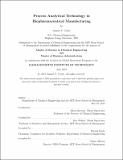Process Analytical Technology in biopharmaceutical manufacturing
Author(s)
Cosby, Samuel T. (Samuel Thomas)
DownloadFull printable version (1.022Mb)
Other Contributors
Leaders for Global Operations Program.
Advisor
Allan Myerson and Roy Welsch.
Terms of use
Metadata
Show full item recordAbstract
Process Analytical Technology (PAT) became a well-defined concept within the pharmaceutical industry as a result of a major initiative by the FDA called "Pharmaceutical cGMPs for the 21st Century: A Risk-Based Approach." The FDA defines PAT as "a system for designing, analyzing, and controlling manufacturing through timely measurements (i.e., during processing) of critical quality and performance attributes of raw and in-process materials and processes, with the goal of ensuring final product quality." The biotechnology industry has started incorporating PAT in manufacturing, because of regulatory pressure and because the previous blockbuster-oriented business model is becoming less viable. This thesis proposes a methodology for evaluating PAT systems and delivers guidance on how to develop and implement them to effectively manage risk in biopharmaceutical manufacturing. The methodology includes guidance regarding identifying opportunities, evaluating and implementing novel analytical technology, appropriately applying acquired data, and managing change associated with PAT implementation. Experimental results from a novel PAT system that acquires light scattering and UV absorbance data to control chromatography during large-scale manufacturing are presented as a case study. The case study follows the methodology to show how a system optimized for a laboratory can be scaled for use in biopharmaceutical manufacturing.
Description
Thesis (M.B.A.)--Massachusetts Institute of Technology, Sloan School of Management; and, (S.M.)--Massachusetts Institute of Technology, Dept. of Chemical Engineering; in conjunction with the Leaders for Global Operations Program at MIT, 2013. This electronic version was submitted by the student author. The certified thesis is available in the Institute Archives and Special Collections. Cataloged from student-submitted PDF version of thesis. Includes bibliographical references (p. 83-85).
Date issued
2013Department
Leaders for Global Operations Program at MIT; Massachusetts Institute of Technology. Department of Chemical Engineering; Sloan School of ManagementPublisher
Massachusetts Institute of Technology
Keywords
Sloan School of Management., Chemical Engineering., Leaders for Global Operations Program.